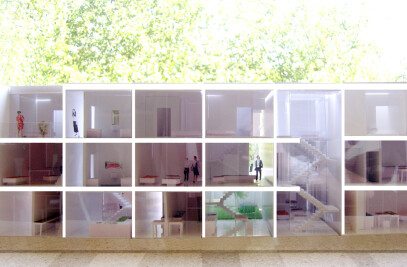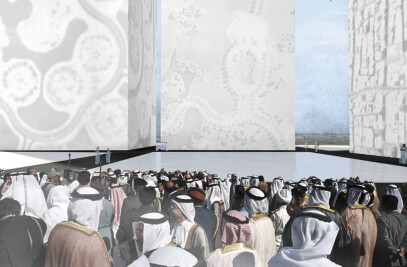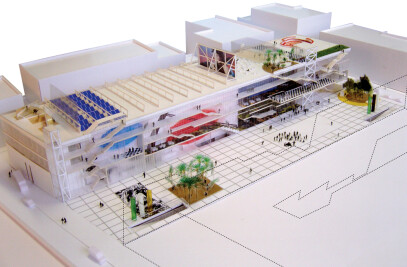Manzana 5 –The development has been commissioned after winning first prize in the Open Competition for Blocks 5 and 6 of the Digital Mile District in Zaragoza
The Re-Creation of Zaragoza Zaragoza is undergoing a huge transformation. It is the 5th biggest city in Spain but for many years stayed too comfortable and closed in itself. The city has become aware of the enormous competition among European cities in this day and age, and in a span of less than 10 years will undergo a radical recreation. Zaragoza is gathering the ten elements of the portfolio we describe in our study The Re-Creation of the European City.
The relocation of Zaragoza Railway Station in the Delicias district and its transformation into a modern intermodal station with High Speed trains has kick started the regeneration of the entire area, which works according to an ambitious master plan called the Digital Mile* District, where the City is collaborating with MIT (Massachusetts Institute of Technology) and experts such as Willian Mitchel, D. Manuel Castells, and Saskia Sassen. Zaragoza will play host to the next International Exhibition in 2008. The site of the Expo is fairly close to the Digital Mile, which will benefit from the event. Manzana 5 enjoys the most privileged location in the Digital Mile: right in front of the new station and the Plaza Sur.
Manzana 5 is a mixed-use block of 43 metres in height and a 123 by 63 metre base.
Imposition The brief of the competition predetermined strictly the volume of the blocks: two rotund trident profiles with the three slabs of each block facing each other, and not the main avenue or the new railway station, as was expected. After a predictable initial reaction looking to modify this shape, we feel intrigued in discovering the reason for this apparent incongruence. By studying the master plan we understood the decision. The shape of the blocks is not following any architectonic approach but a much more urban one: rather than creating a façade, the blocks want to disappear into the smallest silhouette to make the station visible to the city. We imagined how two large pieces were cut out of each of the initial volumes. To illustrate this aggressive gesture we will treat the surfaces that were always meant to be exposed differently from the surfaces that are left exposed as a result of creating the silhouette.
Ever-changing rigidity To compensate for the rigidity of the brief and the imposition of the shape of the block we will choose a façade that will forever be changing. We will cover the exterior surfaces equally with glass laminated with a diachronic film, a material that can reflect any colour. The perception of the colour of the Manzana 5 will never stay the same. We will not know what the building will look like until it is finished and even then we will never be able to control its image. It will change from white to red, to yellow, to pink, to golden… It may look stunning, beautiful, subtle, hideous, or delicate, all on the same day. The inner surfaces will be treated delicately with glass in different white tones. The use of only one material to cover the 12,000 m2 of external facade emphasises the rigid silhouette of the trident and stresses the appropriate large scale of the block; in contrast, the diachronic film will provide the building with an ever-changing image.
Looking for the finest image The urban gesture of the block, that positions the slabs perpendicularly to the main avenue and to the Station Plaza, compromises the views from the apartments and offices, which will have to view each other or look at the communal garden. We accepted this urban gesture as a valid strategy to keep the station view of the city, but we felt that something had to give in exchange so the daily view of the users of the slabs would be enhanced. Looking for what could possibly be the finest view we researched the oeuvre of Francisco de Goya, born in Zaragoza in 1746, and to our surprise we discovered that his painting La Maja Desnuda (The Nude Maja) is of the same proportions as the Manzana 5 plan. This painting is one of the best-known works by Goya and the first entirely profane life-size female nude in Western art. The garden will feature this painting, scaled up in size 65 times, in pixelated format using a system of grass and vegetation tiles that collect the rain water. The ever changing character of Manzana 5 will enter into dialogue with the urban context. Users of the buildings will never be able to see these changes when inside. They will be looking at serene whitish inner facades and the beautiful Goya painting. Internet users will also be able to enjoy the 100 metres tall Maja Desnuda when visiting Zaragoza through Google Earth.
Architecture solves the problems of urban planning Due to the rush in conceiving the urban plans for Manzana 5 and 6 we encountered a big problem while developing the building that could seriously compromise its design: the building, as proposed in the master plan, did not comply with fire regulations. The time constraints made the modification and further approval of a new master plan impossible. The solution proposed by the fire department of the City was to open up a street and cutting the block in two, to allow for the access of fire engines to the core of the building. To our mind, this was a very poor solution, as it compromised the coveted large scale of the block; it was also undesirable to the client who would lose an awful lot of valuable retail space and the possibility of constructing a large mall, rather than two disconnected commercial pieces. By studying carefully the fire regulations and by meeting the firemen on several occasions we came up with a simple fire safety concept that would not require any cuts to the building, nor any extra investment, whilst making more space available for housing. We planned a big staircase to the common gardens, which would be considered a ‘safe place’, becoming a second ground-floor from where users may be evacuated. We also proposed duplex apartments on the top floors, reducing the “escape height” of one floor. These users will have an alternative emergency exit, an ascendant escape route, that will lead them to the roof of the blocks, from where they will be able to descend using another staircase to the ground-floor. In this way we eliminate half of the stairs in each block, freeing up this space to the apartments. Architecture solved the problems of poor urban planning.
The required programme of Manzana 5 is composed of 60,000 m2 of residential, administrative, parking, and retail programme. Within the block we will allow maximum flexibility in housing typology. It contains 168 apartments from 100 possible different typologies, all fitting within the same structural grid and services layout. The smallest is 40 m2 and the largest is 180 m2.

































